How to sow Exhibishen onions for seedlings: rules for growing and care at home
Most likely, the giant bulbs that you saw from your neighbors or on the Internet (for example, in the pictures of the harvest or in the same videos on YouTube) prompted you to grow Exhibitive onions.
You may not believe your eyes at first, thinking that it is "Photoshop", but with proper care, they can really grow just that size.
Well, then we'll talk about what needs to be done to get the same huge harvest, namely: how to properly sow the Exhibitive onion seeds for seedlings, and then take care of it when planted in open ground.
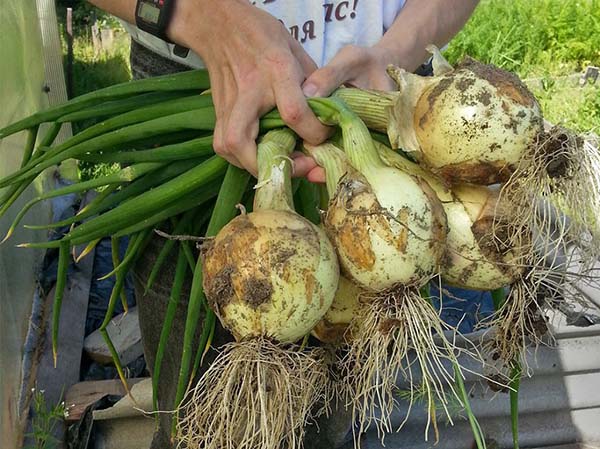
Content
- 1 Description of the Exibishen bow: characteristics and features
- 2 When to plant Exhibitive onions: for seedlings and in open ground
- 3 How to sow Exhibishen onions for seedlings correctly
- 4 Planting seedlings in open ground
- 5 Onion cultivation Exibishen in a non-seedling way - direct sowing in open ground
- 6 Outdoor onion care
- 7 When and how to harvest
Description of the Exibishen bow: characteristics and features
This onion was bred in Holland by the seed company “Bejo Zaden”.
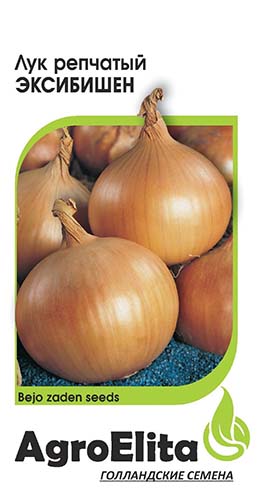
The main quantitative and qualitative characteristics of the Exibishen onion:
- Medium-late ripening (from germination to maturation - 110-130 days).
- The taste is canceled - the onion is juicy, tender and sweet. Ideal for fresh consumption, in other words, for salad purposes. Of course, it is also suitable for conservation (preparations for the winter).
- The shape of the bulbs is round-elongated (there are both perfectly round and elongated ones).
- Bulbs weigh on average from 170-550 grams, individual ones - up to 0.8-1 kg (maximum - up to 1.2 kg). It all depends on the growing conditions and care.
Really large bulbs can only be obtained from seedlings.
- It is believed that this variety is not suitable for long-term storage. At the same time, it is indicated that the maximum storage period is up to 3-4 months (i.e. until the New Year)).
However, some gardeners manage to store it in the basement or cellar until March.
When to plant Exhibitive onions: for seedlings and in open ground
We all live in different climatic zones, which means that the sowing time for each region will be different.
You can calculate the timing of sowing Exhibichen onions for seedlings yourself. So, the optimal age of seedlings for planting in open ground is about 2 months (50-60 days), although in the South of Russia it can be planted at the age of 35-40 days.
It should also be borne in mind that it will take 2-4 days for pecking and germination of seeds, and 3-7 days for seedlings (sprouted, naturally, germinate faster).
Thus, if you live in the South, then you can sow for seedlings in the second half of February, in order to plant in April.
In the Middle lane (Moscow region) - not earlier than March, to land in the first half of May.
A little later in the Leningrad region, namely: sowing should be done in the second half of March, in order to plant in the second half of May.
In the Urals and Siberia - in the second half of March-early April, to land in the second half of May-early June.
Note! It should be understood that in the conditions of the Middle Belt, the Leningrad Region, or even more so the Urals, it will hardly be possible to grow a kilogram onion for obvious reasons, but a 500 gram onion is quite realistic.
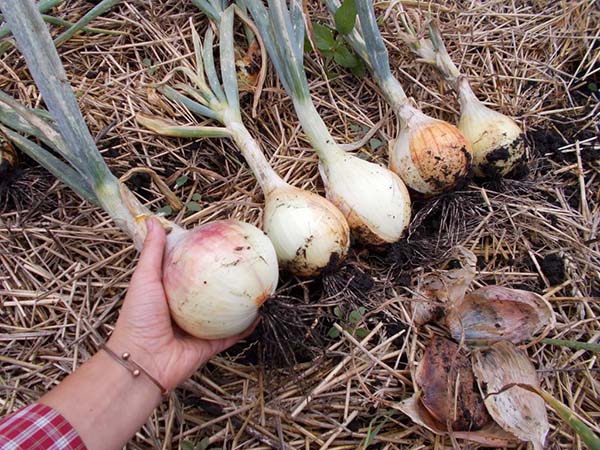
How to sow Exhibishen onions for seedlings correctly
To get a really rich harvest of Exible Onions, you first need to grow good and healthy seedlings. And above all, prepare the seeds, soil, sowing containers and properly sow the seeds itself.
Seed preparation
As a rule, Exhibitive onion seeds are sold already processed, in other words, draped.
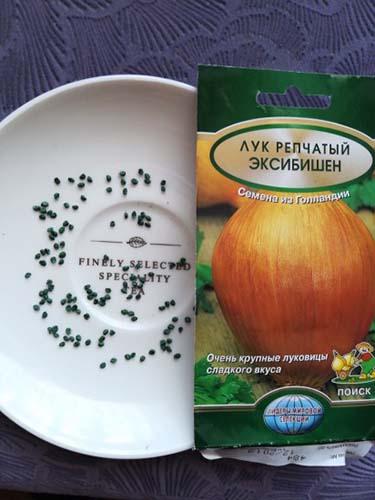
However, before planting, if desired, they can still be germinated, because the germination capacity of even such glazed (treated) seeds is sometimes less than 80%.
You can germinate onion seeds as follows:
Note! You need to germinate correctly: if you just immerse the seeds in water, then no effect will follow, because oxygen is required to awaken them.
- Pour out the grainsin moistened multilayer gauze (although it's better to use a cloth ragsince they can grow into cheesecloth with roots) oron cotton pads: put the grains on the lower disc, close with the upper one. The disks themselves, of course, are pre-moistened! Instead of disks, you can takenapkins.
Important! The water that you use for wetting should be settled or filtered, as an option, rain or melt.
- Then put on a saucer (or in another container), and cover the top with a plastic bag (cling film) to create greenhouse conditions so that the moisture does not evaporate longer;
Important! A rag, cotton pads, or seed napkins should be constantly wet, but not in a puddle of water.
- Place the container of soaked seeds in a warm place, such as a kitchen cabinet.
The optimum temperature for seed germination is + 24 .. + 28 degrees.
- When the seeds hatch and germinate, and this usually takes 2-4 days, they must be immediately planted in the ground.
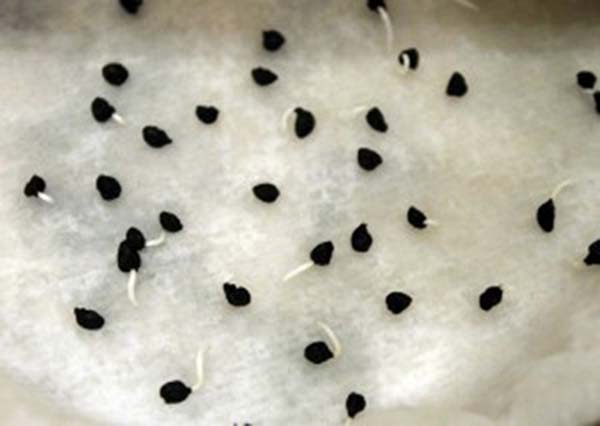
Soil preparation and sowing tanks
The seedling soil should be loose (moisture and air permeable) and moderately fertile, as well as non-acidic (neutral acidity).
Soil mixture for onion seedlings Exibishen can be prepared according to one of the following recipes:
- humus or compost and sand in a 1 to 1 ratio;
- turf soil, humus or compost and sand in a 2: 2: 1 ratio.
- peat, humus coconut substrate and sand.
Or buy ready-made universal soil for growing seedlings. If it is too dense, then it must be loosened with sand, perlite or a similar baking powder.
Important! Be sure to carry out the procedure disinfection of soil (including purchased). This can be done by calcining or steaming in an oven or microwave, or spilling a solution of the drug Fitosporin (according to instructions)... Better yet, do both (first ignite, then cool, and then spill).
Concerning planting tanksthen it is best to take not wide and rather high (deep) individual cups. Ideally - with a volume of 0.2-0.3 liters.
Advice! It is advisable to sow directly into separate cups, so as not to dive later and not injure the seedlings, because of which, in the end, you may not get large bulbs. It is much easier and more painless to transfer from individual containers.
Alternatively, you can sow in peat tablets.
Although if you take deep (10 cm) total capacity, for example, a wooden and plastic container and plant at a sufficient distance (1.5-2 cm), then later it will be possible to plant directly from it.
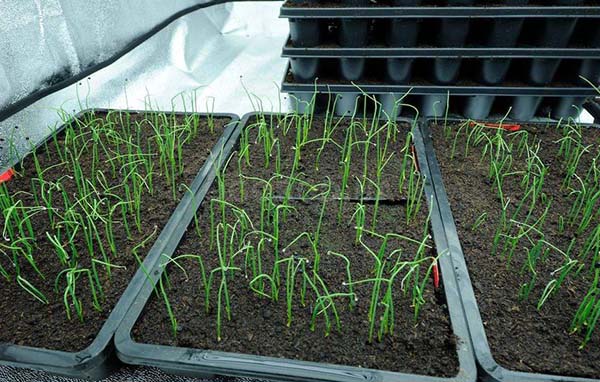
Important! It should be borne in mind, according to the experience of experienced gardeners, thatlarger bulbs are obtained when growing seedlings in individual cups.
Direct sowing
Step-by-step instructions for sowing Exhibishen onion seeds for seedlings:
- Prepared in advance the soil and containers. Disinfected.
- Immediately before sowing, the cups were filled 3/4 full (so that it was convenient to water).
- We made indentations.
- Sowed the seeds. If sprouted, then 1 - in each separate container, if dry, then it is better - 2.
Exhibiting onion grains should be planted to a depth of 1-1.5 centimeters.
- Sprinkled with soil mixture.
- Spilled water.
- Covered with plastic wrap to create a greenhouse effect.
- We put the seedlings in a dark and warm place.
Video: sowing Exhibishen onions for seedlings
Seedling care after sowing and before planting in the ground
As soon as you notice that green sprouts have appeared, the seedlings should be immediately placed on a light window sill (when planting in late March - early April) or under phytolamps (if the daylight hours are still short, for example, you sowed in the second half of February and early March) ...
By the way! After germination, you also need to significantly lower the temperature for several days. In general, this should be done with seedlings of all crops.
Daylight hours should be at least 10 hours, and even better - 12.
If the young seedlings do not have enough light, they will begin to stretch and eventually collapse.
Watering in the seedling period should be moderate. The main thing is to prevent the soil from drying out. At room temperature (+20 .. + 23 degrees), it will be enough to water once every 5-7 days.
As a rule, no additional feeding is required at this stage.
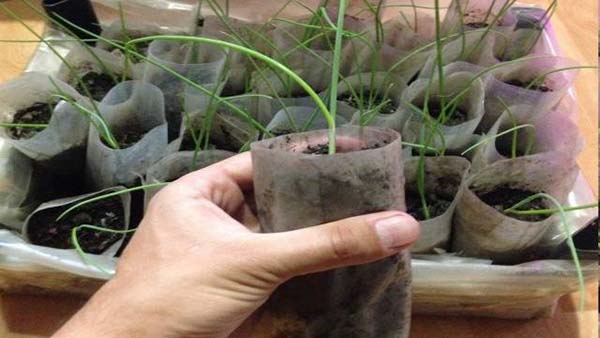
Many gardeners ask themselves the question: "Do I need to pinch (cut) onion seedlings?"
Indeed, trimming the tops of green feathers is beneficial for seedling growth (the feather is trimmed to balance the aboveground mass and roots). However, the frequency of haircuts may differ:
- Some recommend carrying out several haircuts while growing seedlings and immediately before planting in a permanent place.
- Others cut only immediately before or immediately after planting in open ground.
Interesting! Some summer residents trim their feathers a few days before planting so that the tops dry out and do not attract onion flies.
However, if the weather is relatively cool and windy, then the onion fly is not in the active phase.
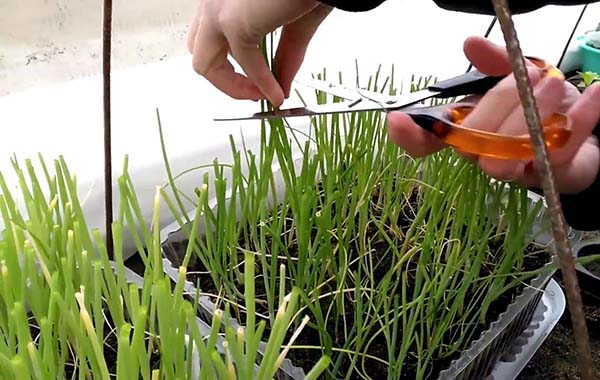
At the same time, feathers need to be shortened to 10-12 cm.
Video: growing seedlings of Exibishen onions
Planting seedlings in open ground
Exhibitive onion seedlings, ready for planting in the ground, should have a well-developed root system (if they were sown in cups, the roots will be clearly visible) and 3-4 sufficiently high feathers, so to speak, the size of a "goose feather" (15-20 cm ).
It is not necessary to wait until return frosts have passed. Onions are a fairly cold-hardy culture, capable of withstanding small drops in temperature.
Location and ground
There are no special soil requirements for the successful cultivation of Exhibitive onions. Naturally, like many other cultures, onions loves fertile and non-acidic soil.
And the place itself (garden) should be in an open and well-lit area.
It is also very important that the soil was loose and well-drained... Therefore, before planting seedlings, it (soil) should at least be carefully dug onto a shovel bayonet (25-30 cm) and loosened with a hoe and a rake, or even better, loosened with a walk-behind tractor.
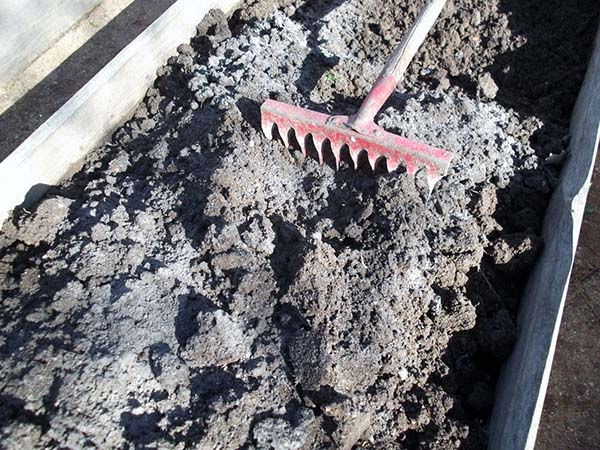
Advice! To increase soil fertility before planting (during digging) it is advisable to make 1 sq.m. beds 1 bucket of humus or compost (8-10 kg) and 1-2 glasses wood ash (100-200 grams). If you allow the use of mineral fertilizers, then by the way it will be nitroammophoska (25-35 g / m2).
Transplanting
Step-by-step instructions for planting Exhibishen onion seedlings in open ground:
- Slightly spill the garden bed with warm water, or even better with a solution Fitosporin (prepare solution according to instructions).
- Make holes or grooves according to the size of the planting containers.
The Exibition bow is a giant bow, which means it needs a lot of space and food. Therefore, accordingly, plants should be planted at a distance of about 30-40 cm from each other. Of course, if you have a lot of seedlings, then you can plant closer - 10 cm between plants in a row and 20 cm between rows (optimally still 20 by 30 cm), but the bulbs will be noticeably smaller.
- Take out the seedlings along with a lump of earth and plant them in the holes.
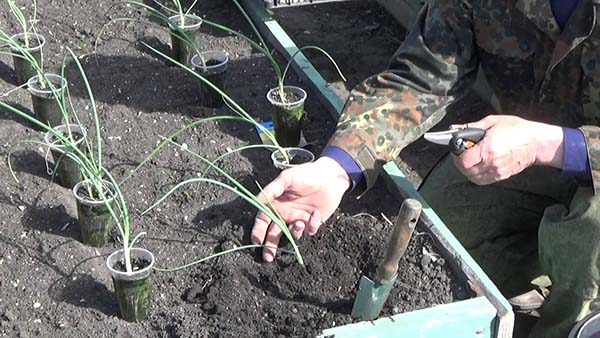
If you grew onion seedlings in a common container, then you need to get it along with an earthen clod and place it in a container with water to clear the roots of the soil and separate one plant at a time for further planting.
By the way! You can not only cut the top to 10-12 cm, but also cut the roots (by 1 cm) so that they can be conveniently removed into the hole and do not bend.
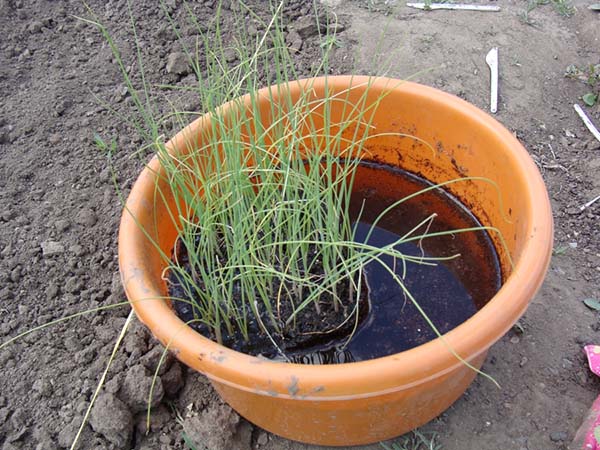
- Sprinkle with soil, level.
Only the onion (the white part of the seedling) should be underground.
- Spill well with warm water (about 1 liter per plant).
The soil should completely settle, and the root system should get maximum contact with the ground.
- If necessary (if you live in an arid region), mulch, for example with straw or sawdust.
In general, mulch retains moisture better, prevents the soil from overheating and weeds grow.
Video: planting a bow Exibition with secrets
In the video, the author shows the planting of seedlings with many nuances, including protection from onion flour.
And the next video shows a much simpler planting of seedlings.
Video: planting Exibishen onion seedlings in open ground
Cultivation of Exhibishen onions in a seedless way - direct sowing in open ground
Of course, Exhibiting can be grown without pre-sowing seedlings.
Important! However, in this case, you will not be able to achieve kilogram bulbs.
The very sowing of Exhibishen onion grains directly into the open ground is carried out in a previously prepared and well-loosened soil, as well as for seedlings, to a depth of 1-1.5 centimeters.
Next, you will need to plant it or thin it out. The final, the first is preferred.
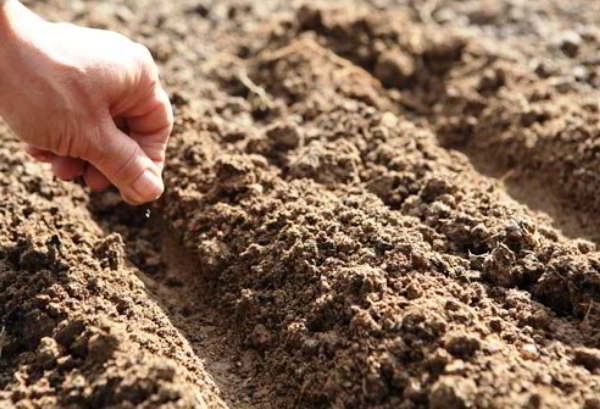
Outdoor onion care
For good growth, onions require proper care: timely watering, loosening and weeding from weeds, as well as top dressing (if necessary).
Before rooting (when the seedlings take root and start growing), it is advisable to water more often. Then watering should be carried out as soon as necessary and depending on weather conditions.
For example, if it rains often, then it will not be needed at all. But if the weather is hot, about + 30 degrees, then it is recommended to water the onion every 5-7 days.
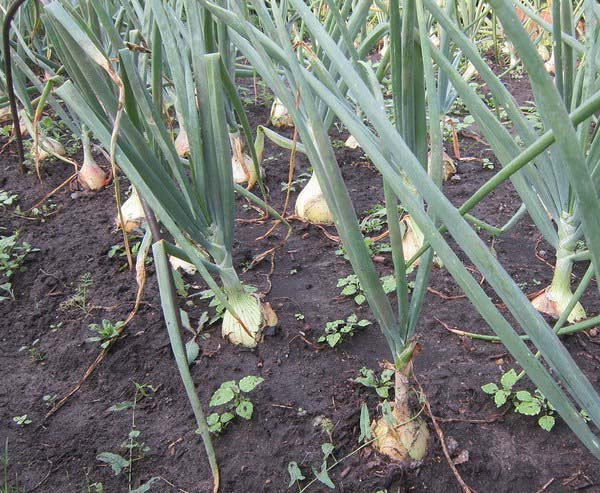
Note! With insufficient watering, the onions become more bitter.
By the way! The site already has a general articleabout the rules for watering onions.
2-3 weeks before harvest it is necessary completely stop all watering.
If you mulch the garden, then not only will you not have to water the onions often, you will also practically get rid of such an unloved procedure as loosening and weeding from weeds.
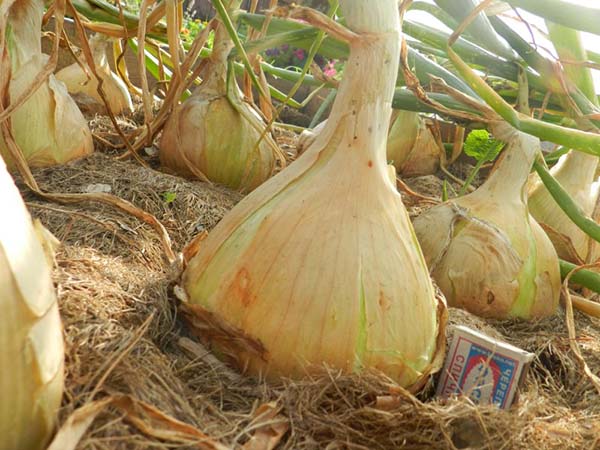
If you grow without mulching, then after each watering it is desirable loosen the ground and periodically weed, and the weeded grass can be left directly on the garden bed.
Concerning top dressing, then they may not be carried out if you initially brought humus to the garden bed and wood ash.
In general, you need to feed on wet soil. In other words, after watering or rain.
However, if you doubt the fertility of your soil (and large onions will not grow in poor land), then you can make the following top dressing:
- 2 weeks after planting seedlings in open ground, it is advisable to perform nitrogen feeding, for example, a solution of chicken manure or mullein (for organic lovers), or urea (if you allow the use of mineral fertilizers). Prepare all solutions according to package instructions.
Fertilizing onions is very good. based on humic acids, such as Humate Potassium, Gumat + 7, Gumi Kuznetsova, Gumi-Omi.
- Next, you can feed potash fertilizer (potassium contributes to the growth of the bulb, its mass gain). For example, prepare an ash infusion or use potassium sulfate (potassium sulfate). It will be enough 2 dressings with a frequency of 10-14 days.
Important! If you want to get a large onion, then you should not cut his feather on greens, otherwise, the turnip will simply slow down in development.
Diseases and pests
The main pests of onions, as you know, are onion fly. Actually, Exibishen is also no exception.
How can you resist her?
- For example, sow carrots next to onions, which will scare away pests with their smell.
The smell of tar, chopped garlic, wormwood also scares off the onion fly well. Alternatively, you can spray tobacco while the fly is active.
- Mulch the beds with grass or sawdust.
It often happens that the onion begins to rot right in the garden. Usually, rot arise due to excessively thickened plantings or high humidity (too frequent watering).
It is especially important that the onions are not in damp ground before digging up.
Therefore, watering is stopped 2-3 weeks before harvesting. And if it is rainy weather, a lot of precipitation, then it is advisable to make a canopy over the garden bed so that excess moisture does not get on the onion. In this case, it is important that there is good air exchange under it.
When and how to harvest
Harvesting of onions begins when the green feathers turn yellow, dry out and lie down.
Important! If heavy rainfall is expected in the near future, and the onion is about to be ready for harvest, then it is better to harvest the crop prematurely, since such a large onion as Exhibichen is highly prone to rotting. Therefore, it is better to let it dry in a ventilated and semi-dark room.
As for the approximate dates, it is usually the second half of August.
Note! Do not delay harvesting, otherwise the onions will begin to grow again and the bulbs will become unsuitable for even short storage.
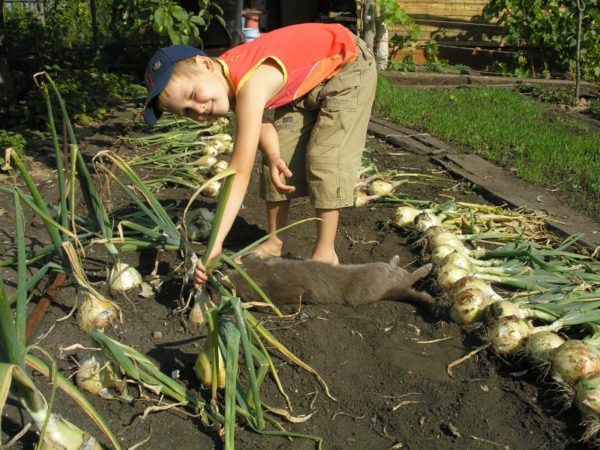
After you dig up the bulbs, be sure to let them dry well for 2-3 days, naturally, not in the heat, under the sun, but in partial shade (for example, in a shed or shady corner of the garden).
Advice! The site already has a general article aboutwhen to harvest onions and how to store them in winter.
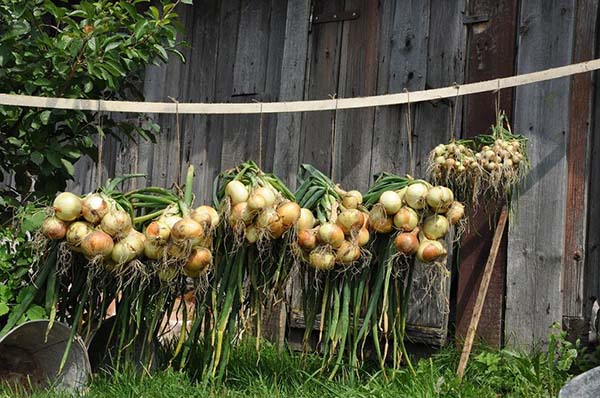
Next, you will need to cut off the roots and cut off the dried top.
Then put into storage in a dry and cool place (4-5 degrees).
Video: Exibishen onion - harvesting
Thus, even a novice gardener will be able to grow a delicious Exhibishen salad onion on his site, of course, if he follows the basic rules and recommendations for sowing and caring for seedlings.
Video: the technology of growing Exibishen giant onions - from seeds to bulbs

